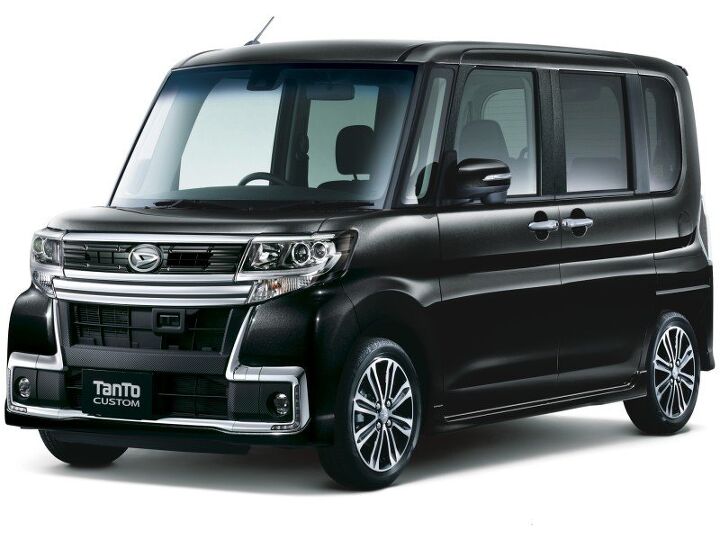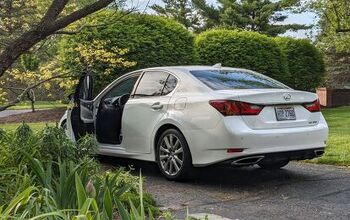Government Intervention is Intentionally Killing the Japanese Kei Car

Anyone with an interest in odd cars probably has at least a passing fascination with Japanese kei cars. As a member of that small subset of enthusiasts, I have a long-held fantasy that involves owning a Suzuki Alto Works, Daihatsu Mira Turbo, Honda Today, or Honda Acty. But the closest North America ever got was the i-MiEV, which Mitsubishi stretched a few inches to comply with U.S. crash ratings — nullifying its official status as a kei.
Sure, most kei cars are utter garbage from a driving perspective, but their utilitarian quirkiness and microscopic road-presence are difficult to replicate on anything other than a moped. They’re also stupidly affordable, which is one of the reasons they’ve persisted in Japan.
However, that’s beginning to change now that their home country has begun taxing them into extinction. The miniature breed, brought to life specifically so budget-minded motorists can have a vehicle and always find parking, lost roughly 25 percent of its yearly volume since Japan targeted them in 2014 — resulting in a sudden annual deficit of nearly 550,000 pint-sized vehicles.
If you’re wondering why Japan would go out of its way to handicap its automotive industry, it isn’t. Since the vehicles are so specialized, they’re not widely exported and thereby not particularly profitable. Australia and Europe has received the odd one from time to time, and mainland Asia gets a handful of modern-day examples (mainly in India), but no country is really begging for them.
Japan has raised gasoline and sales taxes, while also increasing the kei-car tax by 50 percent in 2014, making a them cost roughly the same to run as any other automobile with a smallish engine “We need to rebalance our priorities,” Yoshitaka Shindo, the minister for internal affairs, said ahead of the 2014 tax adjustment.
But there is a problem. The general public still loves them. Despite the massive decrease in sales over the last two years, Japanese consumers still bought 1.72 million kei cars in 2016. Their svelte figure makes city parking a breeze and, since most driving distances aren’t nearly as long as in North America, owners are happier to occupy a less-than-premium interior for the duration. The government also doesn’t require owners of the little runabouts to prove they have purchased a parking space for them, which is mandatory on larger vehicles.
The elderly are among kei’s biggest fans, having purchased the yellow-plated cars after their post-war introduction and then stuck with them. “You can manoeuvre the car even if the streets are really narrow,” 75-year-old Yoko Kojima, whose Daihatsu Tanto doubles as a van for her part-time flower delivery business, told Agence France-Presse. “It’s really easy to drive — I adore it.”
Youths, who have faced similar economic perils to Western Millennials, also strongly prefer kei jidōsha over larger offerings due to their initial affordability.
Even some automakers are opposed to the idea of Japan’s self-imposed war on the little cars. Osamu Suzuki, chairman of Suzuki Motor, has been fairly outspoken against tax hike and has said the move amounts to “bullying the weak.” However, Suzuki has a more-vested interest in smaller automobiles than its rivals.
Asako Hoshino, vice president at Nissan, doesn’t believe the ultra-small economy cars will vanish from Japan’s landscape entirely but is substantially less interested in them persisting as a ubiquitous feature. “Twenty years ago, cars were a symbol of success, but that is not necessarily the case today,” he said. “The trend now is to reduce the size.”
Small-car expertise was one of the primary reasons Nissan acquired Mitsubishi in 2016. Mitsubishi currently sells numerous kei-rated vehicles on the Japanese domestic market — including the eK, which starts at roughly $9,000.
The long-term prognosis is not good, though. While the Japanese public maintains its love affair with all things tiny, the government has made it is mission to wean them off infinitesimal autos.
“I don’t see a bright future for kei cars,” Yoshiaki Kawano, an analyst at IHS Markit consultancy, explained. He then added that a consumption-tax increase planned for 2019 could further harm kei sales.
[Images: Daihatsu, Mitsubishi]

A staunch consumer advocate tracking industry trends and regulation. Before joining TTAC, Matt spent a decade working for marketing and research firms based in NYC. Clients included several of the world’s largest automakers, global tire brands, and aftermarket part suppliers. Dissatisfied with the corporate world and resentful of having to wear suits everyday, he pivoted to writing about cars. Since then, that man has become an ardent supporter of the right-to-repair movement, been interviewed on the auto industry by national radio broadcasts, driven more rental cars than anyone ever should, participated in amateur rallying events, and received the requisite minimum training as sanctioned by the SCCA. Handy with a wrench, Matt grew up surrounded by Detroit auto workers and managed to get a pizza delivery job before he was legally eligible. He later found himself driving box trucks through Manhattan, guaranteeing future sympathy for actual truckers. He continues to conduct research pertaining to the automotive sector as an independent contractor and has since moved back to his native Michigan, closer to where the cars are born. A contrarian, Matt claims to prefer understeer — stating that front and all-wheel drive vehicles cater best to his driving style.
More by Matt Posky
Latest Car Reviews
Read moreLatest Product Reviews
Read moreRecent Comments
- Jalop1991 In a manner similar to PHEV being the correct answer, I declare RPVs to be the correct answer here.We're doing it with certain aircraft; why not with cars on the ground, using hardware and tools like Telsa's "FSD" or GM's "SuperCruise" as the base?Take the local Uber driver out of the car, and put him in a professional centralized environment from where he drives me around. The system and the individual car can have awareness as well as gates, but he's responsible for the driving.Put the tech into my car, and let me buy it as needed. I need someone else to drive me home; hit the button and voila, I've hired a driver for the moment. I don't want to drive 11 hours to my vacation spot; hire the remote pilot for that. When I get there, I have my car and he's still at his normal location, piloting cars for other people.The system would allow for driver rest period, like what's required for truckers, so I might end up with multiple people driving me to the coast. I don't care. And they don't have to be physically with me, therefore they can be way cheaper.Charge taxi-type per-mile rates. For long drives, offer per-trip rates. Offer subscriptions, including miles/hours. Whatever.(And for grins, dress the remote pilots all as Johnnie.)Start this out with big rigs. Take the trucker away from the long haul driving, and let him be there for emergencies and the short haul parts of the trip.And in a manner similar to PHEVs being discredited, I fully expect to be razzed for this brilliant idea (not unlike how Alan Kay wasn't recognized until many many years later for his Dynabook vision).
- B-BodyBuick84 Not afraid of AV's as I highly doubt they will ever be %100 viable for our roads. Stop-and-go downtown city or rush hour highway traffic? I can see that, but otherwise there's simply too many variables. Bad weather conditions, faded road lines or markings, reflective surfaces with glare, etc. There's also the issue of cultural norms. About a decade ago there was actually an online test called 'The Morality Machine' one could do online where you were in control of an AV and choose what action to take when a crash was inevitable. I think something like 2.5 million people across the world participated? For example, do you hit and most likely kill the elderly couple strolling across the crosswalk or crash the vehicle into a cement barrier and almost certainly cause the death of the vehicle occupants? What if it's a parent and child? In N. America 98% of people choose to hit the elderly couple and save themselves while in Asia, the exact opposite happened where 98% choose to hit the parent and child. Why? Cultural differences. Asia puts a lot of emphasis on respecting their elderly while N. America has a culture of 'save/ protect the children'. Are these AV's going to respect that culture? Is a VW Jetta or Buick Envision AV going to have different programming depending on whether it's sold in Canada or Taiwan? how's that going to effect legislation and legal battles when a crash inevitibly does happen? These are the true barriers to mass AV adoption, and in the 10 years since that test came out, there has been zero answers or progress on this matter. So no, I'm not afraid of AV's simply because with the exception of a few specific situations, most avenues are going to prove to be a dead-end for automakers.
- Mike Bradley Autonomous cars were developed in Silicon Valley. For new products there, the standard business plan is to put a barely-functioning product on the market right away and wait for the early-adopter customers to find the flaws. That's exactly what's happened. Detroit's plan is pretty much the opposite, but Detroit isn't developing this product. That's why dealers, for instance, haven't been trained in the cars.
- Dartman https://apnews.com/article/artificial-intelligence-fighter-jets-air-force-6a1100c96a73ca9b7f41cbd6a2753fdaAutonomous/Ai is here now. The question is implementation and acceptance.
- FreedMike If Dodge were smart - and I don't think they are - they'd spend their money refreshing and reworking the Durango (which I think is entering model year 3,221), versus going down the same "stuff 'em full of motor and give 'em cool new paint options" path. That's the approach they used with the Charger and Challenger, and both those models are dead. The Durango is still a strong product in a strong market; why not keep it fresher?




































Comments
Join the conversation
As fun and practical as these look, if your size is anything like mine (6-2, 200 lbs), you will. not. fit. We had a Mitsubishi microtruck at work--the rear seat cushion is bolted to the back of the cab and I was wedged between it and the wheel, knees under it and the dash. It was good for shuttling packages and test equipment between buildings and that was about it. We have a kei collector here in town and he has a rather impressive collection of Japanese fire trucks, Honda Beats, and various other microcars. With rare exceptions, I can't even sit in them, much less drive them. I once owned, and comfortably drove, a Bugeye Sprite, though top-down was pretty much a requirement. It was a limo in comparison.
Daihatsu Copen! No roof No cubic inches No problem